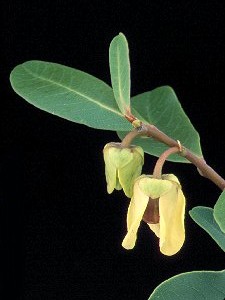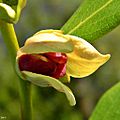Four-petal pawpaw facts for kids
Quick facts for kids Four-petal pawpaw |
|
|---|---|
 |
|
| Conservation status | |
| Scientific classification | |
| Genus: |
Asimina
|
| Species: |
tetramera
|
The four-petal pawpaw (scientific name: Asimina tetramera) is a special flowering plant found only in Florida. It's either a small tree or a large shrub that lives for many years. This plant is very rare! There are only about 950 of them left in the world. They all grow in just two counties in Florida: Martin and Palm Beach. Because it's so rare, the United States government has listed it as an endangered species. This means it's in danger of disappearing forever.
Contents
What Does the Pawpaw Look Like?
The four-petal pawpaw usually grows to be about 1 to 3 meters (3 to 10 feet) tall. Its stems can be brown, reddish, or grayish.
Leaves and Flowers
The leaves of the pawpaw are about 10 centimeters (4 inches) long. They are green on top and a gray-green color underneath. Sometimes, their edges are a little rolled up.
The flowers are quite interesting! They start out pink and change to a maroon color as they get older. They have a strong, unusual smell, which some people describe as "rotten." This smell helps attract insects. Each flower usually has four sepals (small leaf-like parts) and six petals.
Fruit and Seeds
After the flowers, the plant produces a fruit. This fruit is yellow-green and smells like bananas! It's an aggregate fruit, which means it's made up of many small fruits joined together. The pollen from the pawpaw flowers stays in groups of four, called tetrads.
Where Does the Pawpaw Live?
The four-petal pawpaw lives in a special type of habitat in Florida called Florida scrub. This area is often sandy and has specific plants like sand pine (Pinus clausa), saw palmetto (Serenoa repens), and different kinds of oak trees (Quercus species).
Surviving Wildfires
This plant is very tough! It has a strong underground root crown that helps it survive dry weather and even wildfires. In fact, it's a fire-adapted species. This means it actually grows faster and produces more flowers and fruits in the seasons after a fire. If the parts of the plant above ground burn away, new shoots will grow from the roots.
The pawpaw usually grows in the understory, which is the area beneath taller trees. If other plants grow too tall around it, they can block out the sunlight, and the pawpaw might not do well. But when a fire comes through and burns away the surrounding plants, the pawpaw thrives! It can live for a very long time, probably over a hundred years. It can even stay dormant (like sleeping) underground for a while before growing again.
Animals and the Pawpaw
The four-petal pawpaw is an important part of its ecosystem.
Food and Pollination
Its fruit provides food for many animals, including gopher tortoises, raccoons, and different types of rodents, like beach mice.
The flowers are pollinated by beetles. Several kinds of flys are also attracted to the flowers' unique smell, which helps with pollination too.
The Zebra Swallowtail Butterfly
The zebra swallowtail butterfly (Eurytides marcellus) has a special connection with the pawpaw. This butterfly lays its eggs on the pawpaw leaves. When the eggs hatch, the larvae (caterpillars) eat the leaves and flowers of the plant.
Why is the Pawpaw Endangered?
This rare plant faces several threats that make it endangered.
Fire and Habitat Loss
The pawpaw needs natural fires to clear away other trees and bushes that might block its sunlight. When people try to stop fires (called fire suppression), it can harm the pawpaw population. However, too much fire can also be a problem. It can reduce the plants that provide homes for rodents, which help spread the pawpaw's seeds.
Another big threat is habitat loss. As land is developed for buildings and roads, the pawpaw's home disappears. This also breaks up the areas where the plants live, which can reduce the genetic variability (different genes) among the plants. This makes the small population even weaker.
Pesticides
Pesticides, which are chemicals used to kill insects (like those used for mosquito control), can also be harmful. They might reduce the number of insects that pollinate the pawpaw flowers, making it harder for the plant to reproduce.
Protecting the Pawpaw
There are seventeen known places where the four-petal pawpaw grows. Ten of these places are on protected land, like parks. However, several other groups of plants are on private land and don't have any special protection.
One important place where the pawpaw grows is Jonathan Dickinson State Park. Here, park rangers help manage the habitat by doing controlled burns every six years. These controlled fires help the pawpaw thrive by clearing out competing plants, just like natural fires would.
Images for kids




